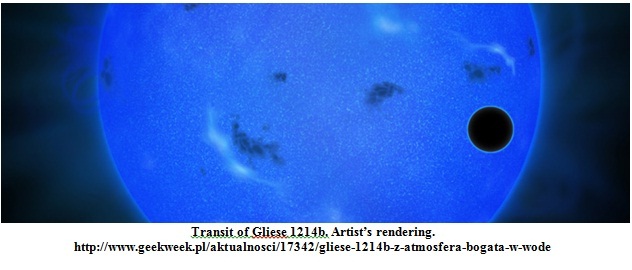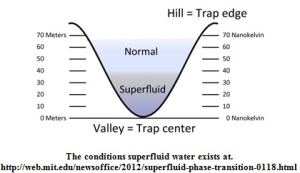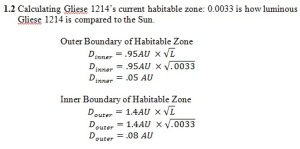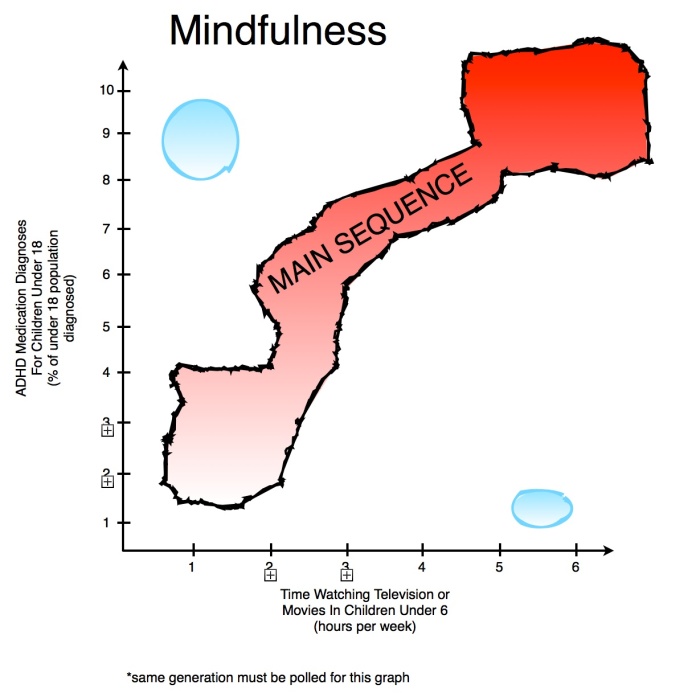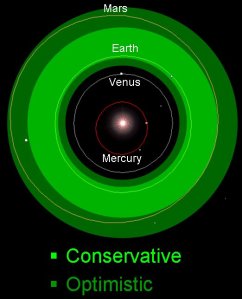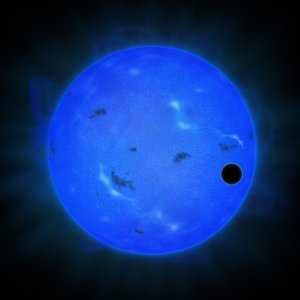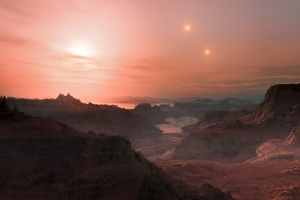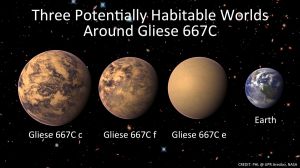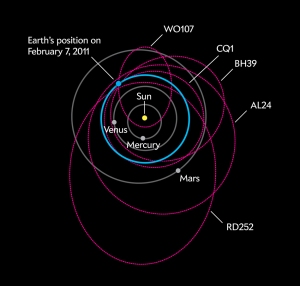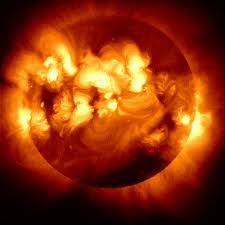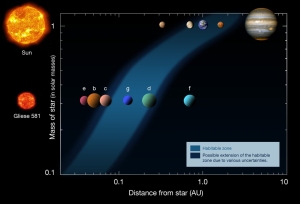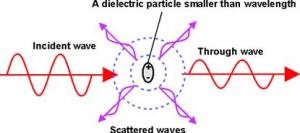Introduction
If Earthling’s ever encounter extraterrestrial life, we will share one thing in common. Us and whatever life we contact, complex or not, will have originated on a planet. Life cannot exist on or in a star because of the extreme conditions nor can it exist on gas giants or icy giants. Life probably cannot and does not exist in or on asteroids and even if it did current detection methods are far from strong enough to detect or study asteroids throughout the galaxy. Astronomers do not search for life in black holes or solar nebulas or supernovas, for obvious reasons. The search for life focuses almost entirely on planets comprised primarily of water or rock. Studying these worlds, scientists hope to find life and if not simply planetary science.
Detection
On December 16, 2009, the MEarth Project confirmed the detection of an exo-planet orbiting nearby red dwarf star, Gliese 1214. The planet, named Gliese 1214b, Gliese tells us the planet orbits a star in the three-star system, Gliese, the number specifies the host star it orbits within the Gliese star system and the letter specifies which planet it is. Its host star Gliese 1214 is located in our immediate neighborhood within the Milky Way galaxy. Gliese 1214b floats forty-two light years away from Earth in the constellation Ophiuchus.
The MEarth Project detected Gliese 1214b using the transit method. To use this method, the observation point must be somewhat edge on in order to observe a planetary eclipse of the host star. As Gliese 1214b passed in front of Gliese 1214, instruments observed 1.50 % a dip in the host stars total luminosity.
With the telescopes fixed on this star the MEarth Project eliminated the possibility that such a dip was caused by an asteroid or comet, when thirty eight hours later they detected the same decrease in overall brightness. Using only transit detection methods, the MEarth Project determined Gliese 1214b’s orbital period and subsequently its orbital velocity, its mass, and its semi-major axis.
Planetary Metrics and Composition
Gliese 1214b orbits Gliese 1214 at a distance of 0.0140 Astronomical Units and completes one full orbit every 38 hours. It is 6.36 times the mass of Earth and its radius is 2.69 times Earth’s. Being larger than Earth and the other terrestrial planets yet smaller than the ice giants of our solar system, Neptune and Uranus, it is characterized as a Super Earth. Such a size raises questions of composition that in 2009 scientists did not have sufficient evidence to answer.
Initially, scientists postulated it was composed mostly of water, though this could not be confirmed. Also, using its mass and radius scientists calculated its density and found it to be denser than water at 5.0 g/cc. Recent research confirms these claims and raises interesting possibilities regarding the habitability of the planet. Gliese 1214b is, in fact, comprised of water and it harbors a thick water vapor atmosphere. The atmosphere was detected using the Rayleigh Effect. When scientists ran models using its observed radius and compared them to actual observations, they differed. They determined that the origin of this difference was caused by a larger radius than scientists previously accounted for. This difference must be the result of a high atmosphere.
Rayleigh Effect diagrams.
http://www.naoj.org/Pressrelease/2013/09/03/
A Thick Watery Atmosphere
The thick atmosphere exerts an incredible amount of pressure on Gliese 1214b’s surface. In addition, the surface temperature is estimated at a range of 393-555 K. The calculations below confirm Gliese 1214b’s extremely high surface temperatures.
At these high temperatures and high pressures, water cannot exist, on the surface, as a liquid. Therefore life, similar to life on Earth, cannot exist on Gliese 1214b’s surface. But, life may exist in its watery core, much like the possibility that life exists in the subsurface ocean, of Jupiter’s moon, Europa.
The conditions superfluid water exists at.
http://web.mit.edu/newsoffice/2012/superfluid-phase-transition-0118.html
Because Gliese 1214b is relatively close to Earth, it offers an opportunity for further study of its atmosphere and internal composition that will increase the accuracy of our estimates and knowledge of its surface and internal conditions. Currently, scientists speculate the presence of “hot ice”, “superfluid water” and “plasma water” on its surface. Life, like life on Earth, cannot exist or evolve in these extreme phases of water. Such a possibility cannot be ruled out because some sort of thermophile may be able to withstand the grueling temperatures and high pressures on its surface, or in the subsurface ocean.
Though this does not seem possible becuase at these high temperatures complex chemistry, essential to life, breaks down. Without the formation of chemical bonds life, of any kind, simply cannot form.
This does not completely eliminate the possibility of life. Below the surface, temperatures may be lower therefore liquid water could exist. The discovery and confirmation, of a subsurface ocean comprised of, at least primarily liquid water would greatly increase the probability of life existing on Gliese 1214b.
A Migratory Planet’s Icy Origins
The presence of liquid water is anomaly because of its close proximity to its host star. Gliese 1214b is such a large planet comprised of approximately 75.0% water. Therefore it is unlikely that asteroid and comet impacts provided all of Gliese 1214b’s water. The nebular theory of solar system formation does not account for Gliese 1214b’s semi-major axis of 0.0140 AU’s. Astronomers hypothesize that Gliese 1214b must have accreted outside the frostline, as an icy planet, explaining the presence of water. Then, they speculate that it gradually migrated inwards, melting the ice and, thus, accounting for the presence of liquid water.
Its original position and subsequent migration inwards inhibited the formation of possibly habitable conditions. When it was icy, habitability was impossible. These uninhabitable conditions must have persisted until it reached its final stable orbit. In its current orbit, Gliese 1214b is outside the habitable zone. The inner boundary of Gliese 1214’s habitable zone is 0.05 Au’s from the star and its outer boundary is 0.08 AU’s from the star. Using the fraction of Gliese 1214b’s luminosity to the Sun’s luminosity, I calculated these boundaries.
Although Gliese 1214b orbits outside the habitable zone, it may still harbor life. This fact simply eliminates the possibility of liquid water existing on the surface, but it may exist elsewhere on the planet.
Life may exist and may have existed since Gliese 1214b’s conception in a subsurface ocean, protected from impacts by a thick icy crust. The migration further confounds the unlikeliness of intelligent complex beings existing on Gliese 1214b. Simple microbial life may exist underneath its surface. It is a possibility, but an incredible small one because of the intense heat and pressure inflicted on the planet by its thick water vapor atmosphere.
Just because life does not persist on Gliese 1214b does not nullify its scientific importance. Astronomers and scientists, alike, are enthused by the opportunity to study its atmosphere and try to determine the causes for its inward migration. This “steamy water world” provides an excellent chance to challenge and strengthen our theory of solar system formation and planetary science. Its proximity to Earth ensures that such studies and resulting discoveries will be a part of the near scientific future.
Bibliography
“Astronomers Find World with Thick, Inhospitable Atmosphere and an Icy Heart | ESO.” Www.eso.org. European Southern Observatory, 16 Dec. 2009. Web. 22 Oct. 2013. <http://eso.org/public/news/eso0950/>.
Bennett, Jeffrey O., G. Seth. Shostak, and Bruce M. Jakosky. Life in the Universe. 3rd ed. San Francisco, CA: Addison Wesley, 2003. Print.
“Gliese 1214.” Open Exoplanet Catalogue. MIT, n.d. Web. 17 Oct. 2013. <http://openexoplanetcatalogue.com/system.html?id=Gliese%201214%20b>.
“GJ 1214 B.” Wikipedia. Wikimedia Foundation, 13 Sept. 2013. Web. 22 Oct. 2013. <http://en.wikipedia.org/wiki/GJ_1214_b>.
Hadhazy, Adam. “Super-Earth or Mini-Neptune? New Technique to Probe Exoplanet Habitability.” Space.com. N.p., 4 Oct. 2013. Web. 22 Oct. 2013. <http://www.space.com/23079-alien-planets-super-earth-mini-neptune.html>.
“New Type of Alien Planet Is a Steamy ‘Waterworld’” Space.com. N.p., 21 Feb. 2012. Web. 22 Oct. 2013. <http://www.space.com/14634-alien-planet-steamy-waterworld-gj1214b.html>.
“Observations Indicate Super-Earth GJ 1214 B Has a Water-Rich Atmosphere.” SciTech Daily. N.p., 4 Sept. 2013. Web. 22 Oct. 2013. <http://scitechdaily.com/observations-indicate-super-earth-gj-1214-b-water-rich-atmosphere/>.
Rayleigh Scattering (physics).” Encyclopedia Britannica Online. Encyclopedia Britannica, 17 Oct. 2013. Web. 22 Oct. 2013. <http://www.britannica.com/EBchecked/topic/492483/Rayleigh-scattering?sections=49248>.
Zolfagharifard, Ellie. “Super-Earth 40 Light Years Away ‘is Rich in Water with a Thick, Steamy Atmosphere’, Confirm Japanese Astronomers.” Mail Online. N.p., 5 Sept. 2013. Web. 22 Oct. 2013. <http://www.dailymail.co.uk/sciencetech/article-2412151/Super-Earth-GJ-1214b-40-light-years-away-rich-water-steamy-atmosphere.html>.

